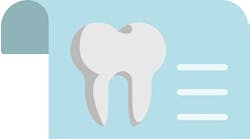BY Brian Hufford, CPA, CFP®
I am an admitted automobile junkie. This hobby is the one area of my life where I could use some financial counseling. I only trade vehicles about once every seven years or so, but I always want to have the latest and greatest options available in our high-tech, gadget-happy world. Perhaps upgrading is a basic human need. I indulge my need for upgrading with vehicles. My frugal father was a General Motors (GM) executive who drove a new GM product every year in support of his employer. Every fall, he chauffeured me to school in a brand new Buick. Sometimes, upgrading is a necessity. In this article, I want to examine the telltale signs that indicate that you may need a significant upgrade to your retirement plan or even to your retirement plan advisor.
Telltale Sign No. 1: You're not saving enough in a 401(k) plan.
My rule of thumb for how much dentists should be saving in a 401(k) plan is simply the maximum amount allowable under current law, which is currently $52,000 in 2014 (amounts for those over age 50 are higher). This figure includes the maximum employee 401(k) contribution of $17,500, plus a safe harbor/profit-sharing amount for the balance. If an employee's spouse works in the practice, I would like to see the spouse contributing $17,500, as well, which would put the desired deductible savings at close to $70,000 per year. With current federal and state income tax brackets, the tax savings would be close to $30,000 for dentists in the highest marginal brackets. Take advantage of this possibility for savings!
Telltale Sign No. 2: Your advisors haven't custom-fit your 401(k) plan to your practice and your goals.
If you aren't saving $52,000 in your 401(k) plan, you should be asking why. I frequently hear responses from dentists who say, "My plan advisor says that my plan won't allow me to contribute that much," or "My accountant says that my S Corporation salary is too low for me to contribute to a profit-sharing plan." These responses indicate either a lack of education or poor priorities in achieving a successful retirement. Maximizing tax-deductible savings should be your highest financial priority, even above debt elimination.
Telltale Sign No. 3: Your employee/staff contributions are more than 20% of total contributions.
Recently, I worked with a dentist who had staff costs that were approaching 50% of total annual plan contributions. The doctor was contributing $40,000 per year with staff costs that were approximately $40,000 per year, as well. When we looked at his 401(k) plan documents, we found that his advisor had not taken advantage of any of the retirement plan design features allowed under the law that would have dramatically reduced staff costs. When we performed a study of the best plan design for his practice, we found that staff costs could be reduced by $30,000 per year with a more sophisticated design. We all want to care for our staff but not at the expense of our own retirement! In this case, we amended the plan to have lower staff contributions, and we implemented a bonus program as a compromise.
Telltale Sign No. 4: You want to avoid the hassle and the cost of 401(k)-plan administration.
Keeping a plan in compliance with the law and amending plan documents for frequent changes as dictated by Congress are not small tasks. Neither are the costs associated with getting the best plan design and administrative help. I frequently talk with dentists who are fed up with all of the paperwork associated with maintaining a 401(k) plan. Many dentists have a "SIMPLE IRA or die" philosophy. For dentists who will diligently find the money to save and who will put up with "the annual 401(k) plan rodeo," as one of our clients describes it, there is no better path for funding an adequate retirement.
Telltale Sign No. 5: You haven't examined a paired-plan arrangement.
With income tax rates at confiscatory levels, the easiest way to cut taxes in half is to pair a cash balance plan with a 401(k) plan. A 45-year-old dentist with a high income could typically achieve tax-deductible savings of as much as $200,000 per year by pairing both plans in the dental practice.
In summary, perhaps this is the year for a significant upgrade to your 401(k) plan. The 65-year-old you will be very happy that you did it.
Brian Hufford, CPA, CFP, is a wealth advisor and dental practice thought leader with Buckingham Advisors, a national, independent wealth and financial advisory firm with a specialty in helping dentists achieve their most important goals. To connect with Brian and Buckingham, visit BuckinghamAdvisor.com, call (866) 545-8816, or email at [email protected].





